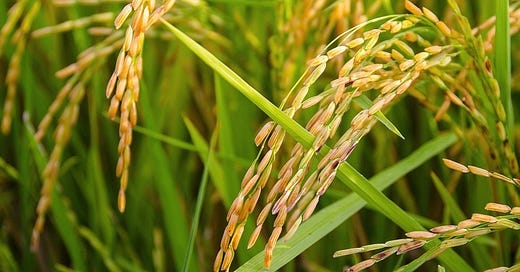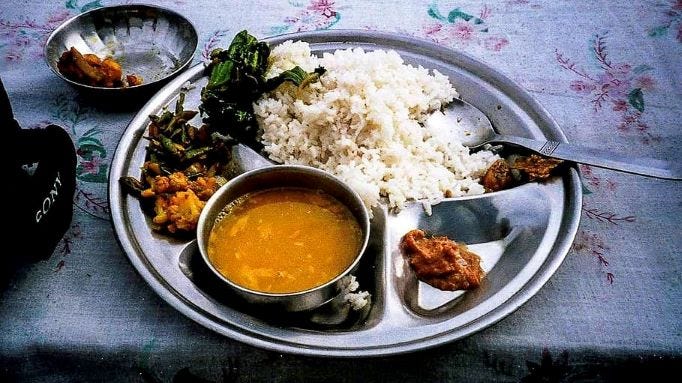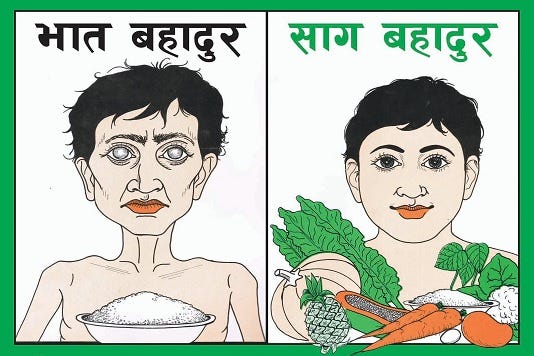By now, I’m sure you’ve heard of India’s recent ban on the export of non-Basmati rice. The prohibition follows India’s recent string of protectionist trade policies, like last year’s ban on the export of wheat, broken rice, and the 20% export duty on various grades of rice. India, a long-time crop-exporting behemoth, explained its curbed exports as a strategy to tackle a potential surge in retail prices in its domestic market. It cites the threat of mass food insecurity as climate change impacts, like insufficient/ erratic rainfall, delayed planting, and heat waves, disrupting agricultural yield.
Such a restrictive move from one of the largest exporters of a staple crop will undoubtedly have global aftershocks. The move could hike food prices globally, enervating a system already shaken by the ongoing Russia-Ukraine conflict. The impacts are more immediate, however, near ground zero in Nepal, where repercussions were felt through an almost instant surge in the price of rice. Nepal loves rice, so much so that the crop has become central to the Nepali identity, and being cut off by one of its biggest (and cheapest) exporters, with insufficient production systems of its own, can wreak havoc on its economy and population.
While the ban can rightfully create anxiety, I think this is a perfect opportunity for the country to rethink its agricultural systems in tandem with sustainability and climate change. Now that Nepal is obligated to explore alternatives, this may present a chance for the nation to free itself from at least one face of dependency on its (often overbearing) neighbor.
So in this substack, I put down my exploration of what this policy action by India means for Nepal and what measures we can take to strengthen our agricultural systems and ensure food security for future generations.
For the love of rice!
It would be an understatement to say that we, the Nepalis, love our rice. Our very own Mukti and Revival even recently released a song about it.
And so the obvious policy question here is: Why is Nepal, a once exporter of rice, increasingly reliant on imports to meet its demands? Before I try to answer that, let me delve a bit into the story of Nepal’s obsession with rice.
This may come as a shock to many, but back in the day, rice was primarily a commodity for export, a stark contrast to the image of the popular staple food that steams in virtually all Nepali kitchens today. Rice was an extravagant choice and, naturally, socially conflated with wealth and status. The Nepali diet instead featured other cereal crops like millet and buckwheat, while rice was saved for celebratory (and rare) meals of festivals like Dashain.
With the rise in population and an increased purchasing capacity of the general public, due primarily to remittances, the preference for rice surged. However, this increase in per capita rice consumption was not due to its nutritional value (which is, in fact, inferior to other cereal crops) but rather because of its historical associations.
Such a rice-centric view is also prevalent at the policy level, where food security in Nepal has long been viewed as rice security. Rice has consistently been the primary focus of food security initiatives, like Food for Work (Ffw) and the School Meal Program (SMP). Food-related programs emphasize rice in their distribution, subsidy, and incentive efforts.
This gradual reinvigoration of appetite for rice was overwhelming for Nepal's already subsistence-level rice production. Additionally, this emphasis on rice inadvertently led to the gradual displacement of traditional crops like millet, buckwheat, and barley, placing the sole catering to Nepali mouths on rice. In the following years, the supply and demand of rice would experience a gap accentuated by several factors:
The lack of a timely and sufficient supply of crucial inputs such as seeds, fertilizer, and water for irrigation significantly hampered the productivity of rice cultivation. In the absence of these prerequisite resources, the low yields were insufficient.
Rice production in Nepal has also been negatively impacted by the changing patterns in migration and also of land use. Labor migration has resulted in a diminished workforce, and changes in land use have made arable land scarcer, especially at the scale required for commercial farming.
Nepal's rain-dependent rice production has been seeing negative impacts from unseasonal rainfall, which experts attribute to climate change. Factors such as poor and untimely monsoons, frequent pests and diseases, and climatic stresses like heat and drought will likely hinder the country's rice production further.
The demand for rice has become highly specific, with consumer preference shifting from locally adapted short-grain varieties to lower-yielding long-grain varieties grown in Nepali soil. This shift is exacerbating the supply-demand imbalance.
With increasing demand and low production, Nepal’s rice import has been on the rise, particularly from India. This trend is due, in part, to the India-Nepal trade treaty which allows for cheaper rates through tariff-free access provisions. The Indian crop is also cheaper because it emerges from surplus and improved trade dynamics resulting from its green revolution. Consequently, the tables have turned: Nepal, once a net exporter of rice to India until 1985, has shifted to importing from India, adding a new layer of dependency to an already extensive list.
Seeking Opportunity in Crisis
As I noted at the outset, we are already experiencing the repercussions of India's recent decision to restrict rice exports. But what I am also certain of is that this is not going to be a one-off event but rather a series of anticipated bans as the effects of climate change further intensify. Therefore, it is essential that we have a plan to strategically counter these possible future crises. This plan should not only focus on increasing the production of rice but also on exploring alternative approaches to ensuring our food security. Here, I present a few recommendations on how Nepal can mitigate the impact of such bans, all while maintaining a sustainable approach:
Introducing and prioritizing locally grown cereal crops in school meal programs to familiarize children with the grain and promote its consumption from an early age. This is especially true of crops like millet, which has a long history of cultivation in Nepal, even in challenging terrain and dry highlands. In comparison to rice, millet offers several advantages. It is rich in dietary fiber and minerals like zinc, calcium, and iron while being low in carbohydrates. Moreover, millet exhibits resilience to drought stress, making it a nutritious and sustainable alternative to rice, particularly in the context of climate change and increasing concerns about water scarcity.
Promoting value addition on various cereal crops by developing a range of food products such as cookies, flour, and chips made from cereals other than rice. This will diversify food options and create economic opportunities for farmers and food processors.
Running awareness campaigns to educate the public about traditional food and its health benefits. Organizing events to exhibit traditional crops and food.
Promote research on disease- and drought-resistant varieties of local crops.
Incentivizing farmers to diversify cereal crop production, providing support through minimum support price schemes, and ensuring a fair income for their produce. Additionally, establishing market channels and strengthening the supply chain will enable farmers to access wider markets and increase their profitability.









